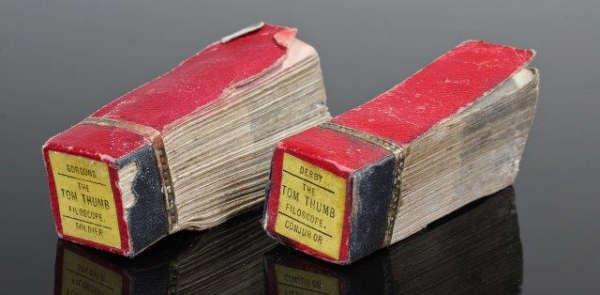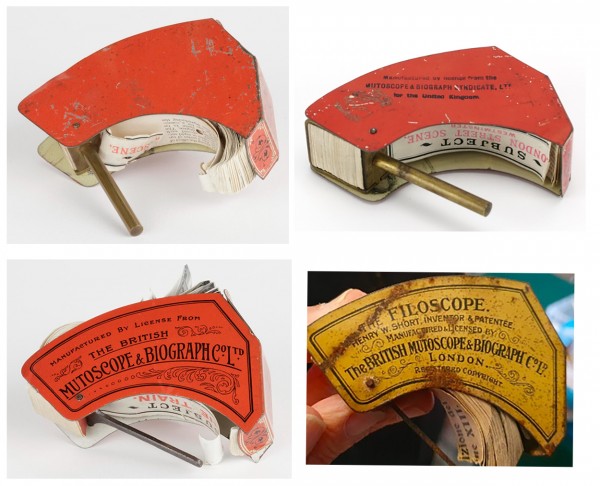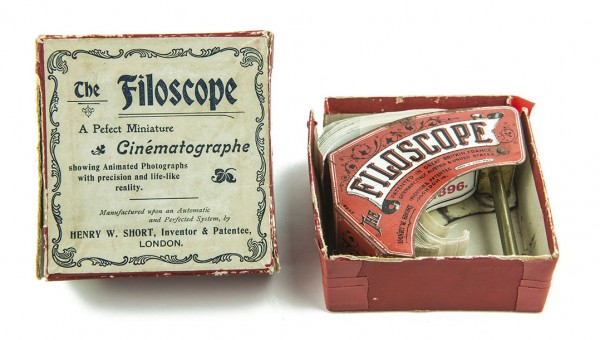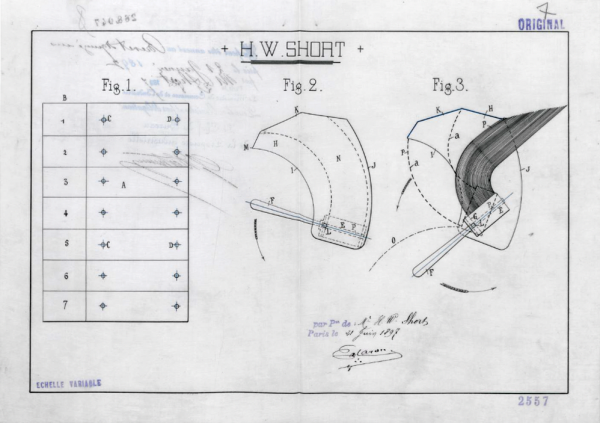A handheld device for viewing photographic flip books, developed by Henry William Short.
Film Explorer

In the second version of the Filoscope, a small flip book was integrated into a metal flipping device. Each page had an image on it and was advanced by pulling a lever, which avoided direct manipulation of the book with the thumb.
National Science and Media Museum, Bradford, United Kingdom.

The only two surviving copies of the earlier “The Tom Thumb Filoscope” flip book. A series of photographic images, reproduced from a 35mm motion picture, were printed on narrow strips of thin card, bound at one end, which could then be flipped through by hand, to recreate the moving images.
Bishop & Miller Auctioneers, Stowmarket, United Kingdom.
Identification
25mm x 18mm (0.984 in x 0.709 in) (Filoscope image).
B/W (photoengraved printing on paper)
24mm x 19mm (0.945 in x 0.748 in) (35mm source).
B/W
History
Robert William Paul, with the help of Henry William Short and Birt Acres, was at the forefront of British cinematography. As early as the summer of 1894, Paul took an interest in the Kinetoscope viewer invented by Thomas Edison and set about creating his own version of the technology in the United Kingdom. The three men began working together, around December 1894, on a project to build a 35mm motion-picture camera to produce new subjects for Kinetoscopes. The camera was operational by March 1895, but after the first known Lumière screening in December that year, their work took a turn, with Paul (in partnership with Short) soon developing a projector as well.
In February 1896, Short filed a patent for an intermittent film advance mechanism, and another in early March 1896 for a type of flip book device – they were described as “book-form kinetoscopes” in the patent. While Short continued to collaborate with Paul until April 1897, he concurrently worked on the development of his flip book ideas.
There are two extant manually operated “The Tom Thumb Filoscopes”, an earlier iteration which appear to be very similar in design, to drawings in Short’s patents for his mechanical device. The leaves of the booklets were printed on both sides of the paper, so that they could be flipped from either side – displaying one title in one direction; and a second when flipped in the reverse direction. The four titles contained in the two existing Tom Thumb Filoscopes are: Derby and Conjurer in one booklet; and Gordons and Soldier in the other. These short sequences were reproduced from 35mm motion pictures originally made by R. W. Paul. The latest images date from the summer of 1896.
In June 1897, Short filed a new patent in France for a “New kinetoscopic apparatus without mechanism, called ‘Filoscope’”. Short was represented in France by Caron, based at 17 boulevard Rochechouart, Paris. It can be assumed that an earlier British patent exists, but it has yet to be located. Although still essentially a flip book, with the Filoscope, the flip book was inserted into a tinplate mechanical flipping device, which provided an interface between the flip book and the viewer. While the name Filoscope referred more specifically to the combination of the flip book and flipping device, it should be noted that this name also appeared on Short’s earlier, standalone flip books. Each flip book, now printed on one side only, along with the flipping device, was sold in a smart-looking box, similar to a presentation case (90mm x 60mm x 22mm), which lent the whole package upmarket appeal.
In February 1897, Short established a new company, the Anglo–French Filoscope Syndicate, to market his products (Brown, 1999: pp. 153–4):
“ANGLO-FRENCH FILOSCOPE SYNDICATE (LIMITED). This Company has been registered by Mr. G. Machieu, of 15, Victoria Street, Westminster, S.W., with a capital of £5000, in £1 shares. The objects of the Company are to acquire, work, develop, turn to account, and deal with the patent rights owned by H. W. Short in England, France, Italy, Austria, Germany, and the United States, and to enter into an agreement with him for the purpose. Registered without Articles of Association. Registered offices, 15, Victoria Street, Westminster, S.W.” (Anon. (1897). “News and Notes”. The British Journal of Photography, 44:1950, (Sep. 17): p. 604).
Short filed several other patents for his Filoscopes through 1897 and 1898. During 1898 and 1899, the Filoscope was covered quite extensively in the pages of both the British and the French press. Initially, Filoscopes were sold directly by Short and by resellers, including the French dealer Henri Kratz-Boussac, known for creating the company “Les Inventions Nouvelles”. Then, in November 1898, the British Mutoscope & Biograph Syndicate acquired a license to produce the Filoscope; subsequently, on January 23, 1899, a new company was incorporated – the British Mutoscope & Biograph Co. Ltd (The Electrical Review, 1899). Its purpose was to build, sell and market Mutoscope and Biograph equipment and films, as well as Short’s Filoscopes. The following was printed on the flip books at the time: “MANUFACTURED BY LICENSE FROM THE BRITISH MUTOSCOPE & BIOGRAPH Co LTD”.
In July 1903, Short was still selling Filoscopes, advertising The Blessing of Our Dying Pontiff from an address in north London – The Studio, 238 Seven Sisters Road. The latest record of Filoscopes dates from 1905, when the British Mutoscope & Biograph Co. Ltd was recorded as retaining stock of 139 boxes of the devices (Brown, 1999: p. 183).
Selected Filmography
Available as a Filoscope flip book under the title Chirgwin the White-Eyed Kaffir. A copy survives at the National Science & Media Museum, Bradford, United Kingdom.
Available as a Filoscope flip book under the title Chirgwin the White-Eyed Kaffir. A copy survives at the National Science & Media Museum, Bradford, United Kingdom.
Available on the Tom Thumb Filoscope. Possibly the same film as David Devant, the Conjurer of the Egyptian Hall, subsequently released on the Filoscope.
Available on the Tom Thumb Filoscope. Possibly the same film as David Devant, the Conjurer of the Egyptian Hall, subsequently released on the Filoscope.
Available on the Filoscope. A copy survives at the National Science & Media Museum, Bradford, United Kingdom, under the title David Devant, the Mysterious Rabbit, although this could be a companion film.
Available on the Filoscope. A copy survives at the National Science & Media Museum, Bradford, United Kingdom, under the title David Devant, the Mysterious Rabbit, although this could be a companion film.
Available on the Tom Thumb Filoscope and the Filoscope. A Filoscope copy survives at the Bill Douglas Cinema Museum, Exeter, United Kingdom.
Available on the Tom Thumb Filoscope and the Filoscope. A Filoscope copy survives at the Bill Douglas Cinema Museum, Exeter, United Kingdom.
Available on the Tom Thumb Filoscope.
Available on the Tom Thumb Filoscope.
Available on the Filoscope. A copy survives at the National Science & Media Museum, Bradford, United Kingdom.
Available on the Filoscope. A copy survives at the National Science & Media Museum, Bradford, United Kingdom.
Available on the Filoscope.
Available on the Filoscope.
Available on the Filoscope. Copies survive at the National Science & Media Museum, Bradford, United Kingdom, and the Bill Douglas Cinema Museum, Exeter, United Kingdom.
Available on the Filoscope. Copies survive at the National Science & Media Museum, Bradford, United Kingdom, and the Bill Douglas Cinema Museum, Exeter, United Kingdom.
Available on the Tom Thumb Filoscope. Possibly the same film as The Soldier’s Embrace, subsequently released on the Filoscope.
Available on the Tom Thumb Filoscope. Possibly the same film as The Soldier’s Embrace, subsequently released on the Filoscope.
Available as a Filoscope flip book under the title The Soldier’s Embrace. A copy survives at the Bill Douglas Cinema Museum, Exeter, United Kingdom.
Available as a Filoscope flip book under the title The Soldier’s Embrace. A copy survives at the Bill Douglas Cinema Museum, Exeter, United Kingdom.
Available as a Filoscope flip book under the title Andalusian Dance. A copy survives at the Bill Douglas Cinema Museum, Exeter, United Kingdom.
Available as a Filoscope flip book under the title Andalusian Dance. A copy survives at the Bill Douglas Cinema Museum, Exeter, United Kingdom.
Also known as Train: Arrival of the Paris Express. Available on the Filoscope.
Also known as Train: Arrival of the Paris Express. Available on the Filoscope.
Available on the Filoscope. A copy survives at the British Film Institute, Berkhamsted, United Kingdom.
Available on the Filoscope. A copy survives at the British Film Institute, Berkhamsted, United Kingdom.
Technology
Henry William Short’s flip books consisted of a sequence of frames printed on between 160 and 174 paper pages, bound together as a booklet. The bound edge, which was wrapped in brass, contained a short metal lever, to aid with advancing the flip book. Each page measured 70mm x 18mm (2.76 in x 0.71 in) and featured a single photo-engraved image measuring 25mm x 18mm (0.98 in x 0.71 in).
The optimal flipping speed of the reproduced images was identical to the running speed of the original film – an analysis of the flip books shows them to be a frame-for-frame reproduction of the source film segment. A digitally recreated animation of the images confirms a speed of about 16 fps, which is consistent with Robert William Paul’s 1896 camera technology – the Theotrograph.
One leaf of the Filoscope was reserved for printed user instructions, which refer to a total of 190 images (a number not found in any of the extant Filoscopes), and a suggests a running speed of 20 images per second. The front leaf contained the title of the film.
Each flip book came with its own flipping device; and when the flip book was mounted in the mechanical flipping device, the combined set became the “Filoscope”. A short metal lever, attached to the flip book, was pulled away from the metal flipping device, with the result that the pages were temporarily caught against one edge, presenting the viewer with a succession of images, creating a moving image.
The earlier “Tom Thumb Filoscope” (without the flipping device) seems to have the same number of pages and the same overall format. However, it was a double album, printed on both sides of the leaves, with two different sets of images, bound back-to-back. Manual flipping was performed in one direction, and then in the other after turning the booklet over.

Four views of Filoscopes. The flip book was mounted within the metal viewer and advanced by pulling on the rod.
Eastbourne Auctions (www.eastbourneauction.com) & Private Collection.

Filoscope of The Derby (1896), in its original packaging.
Bill Douglas Cinema Museum, Exeter, United Kingdom.

London Street Scene, Westminster (1896). Each image was a relatively low-quality, halftone photoengraving – each numbered. The man on the right, in the straw hat, is possibly R. W. Paul.
National Science and Media Museum, Bradford, United Kingdom.

The metal viewer, with mounted flip book (Fig. 2); and with flip book engaged for viewing (Fig. 3).
Henry William Short. Nouvel appareil kinétoscopique sans mécanisme, dit ‘Filoscope’. French patent FR 268,047, filed June 21, 1897, and issued October 22, 1897.
References
Anon. (1897). “News and Notes”. The British Journal of Photography, 44:1950, (Sep. 17): p. 604
Anon. (1898). “Nouvelles scientifiques, Petites inventions, Le Filoscope”. La Nature, 1312 (Jul. 23): p. 51.
Anon. (1899). “La semaine scientifique et industrielle – Les applications”. Le Monde illustré, 2180 (Jan. 7): p. 14.
Brown Richard & Barry Anthony (1999). A Victorian Film Enterprise: The History of the British Mutoscope and Biograph Company, 1897–1915. Trowbridge, Wiltshire: Flicks Book, p. 346.
Electrical Review (1899). The Electrical Review, 44:1 (Feb. 10): p. 212
Hopwood, Henry V. (1899). Living Pictures: Their History,Photo-Production and Practical Working. London: The Optician & Photographic Trades Review, p. 36. Available at: https://archive.org/details/gri_livingpictu00hopw/page/36/mode/2up (accessed March 28, 2025).
Lecointe, Thierry & Jean-Claude Seguin (2025), “The Anglo-French Filoscope Syndicate”. Le Grimh https://www.grimh.org/index.php?option=com_content&view=article&id=11504:1896-1906-productor-filoscope&catid=74&lang=fr&Itemid=127 (accessed February 20, 2025).
Letamendi, Jon & Jean-Claude Seguin (2025). “Henry William Short”. Le Grimh https://www.grimh.org/index.php?option=com_content&view=article&layout=edit&id=2903&lang=fr (accessed February 20, 2025).
Seguin, Jean-Claude (2025). “Robert William Paul”. Le Grimh https://www.grimh.org/index.php?option=com_content&view=article&id=967:1896-1906-persona-paul-william&catid=62&Itemid=680&lang=fr (accessed February 20, 2025).
Patents
Henry William Short. A New or Improved Means for Exhibiting or displaying to view Consecutive Photographs of Pictures of Moving Objects or Figures. British patent UK 4166, filed February 26–March 4, 1896.
Henry William Short. Nouveau genre de kinétoscope. French patent FR 255,292, filed April 3, 1896, and issued July 15, 1896.
Henry William Short. Means for Exhibiting Consecutive Pictures. US patent US 596,910, issued June 25, 1896.
Henry William Short. Addendum to Means for Exhibiting Consecutive Pictures. US patent US 575,761, issued January 26, 1897.
Henry William Short. Nouvel appareil kinétoscopique sans mécanisme, dit ‘Filoscope’. French patent FR 268,047, filed June 21, 1897, and issued October 22, 1897.
Henry William Short. A new or improved holder or casing for book form kinetoscopes. British patent UK 29616, filed December 14, 1897.
Henry William Short. Improvements in kinetoscopic apparatus (the filoscope). British patent UK 23158, filed November 3, 1898, and issued January 7, 1899.
Related entries
Authors
Jean-Claude Seguin is professor emeritus at Lumière-Lyon 2 University. His research focuses on Spanish and early cinema. President of Grimh (1999–2012 and 2024–26), he has taken part in numerous conferences in France and internationally. Visiting professor (Charles III University of Madrid; Harvard University; Cambridge University; Centro de Estudios Mexicanos, UNAM-Reino Unido), he has published over 140 articles and some 15 books, including Histoire du cinéma espagnol (translated into several languages), La Production cinématographique des frères Lumière, Alexandre Promio ou les énigmes de la lumière, Los Orígenes del cine en Cataluña, Pedro Almodóvar o la deriva de los cuerpos. His latest work is on the cinematograph in Spain (1896-1906). He is in charge of the website “Les origines du cinéma (1896-1906)” (grimh.org).
Thierry Lecointe is an independent researcher. He has published articles on early cinema, mainly in 1895 revue d'histoire du cinéma, the proceedings of the Domitor international association and, in 2024, in Photographica. He is the author of Le Cinématographe Lumière dans les arènes (1896–1899) (UBTF, 2007) and Des fragments de films Méliès disparus ressuscités par des flip books, (1896–1901) (Libbey, 2020).
Ian Christie.
Seguin, Jean-Claude & Thierry Lecointe (2025). “Filoscope”. In James Layton (ed.), Film Atlas. www.filmatlas.com. Brussels: International Federation of Film Archives / Rochester, NY: George Eastman Museum.
Margaux Chalançon


